How farmers in British Columbia worked to save a crucial crop from a fast-spreading fungus.
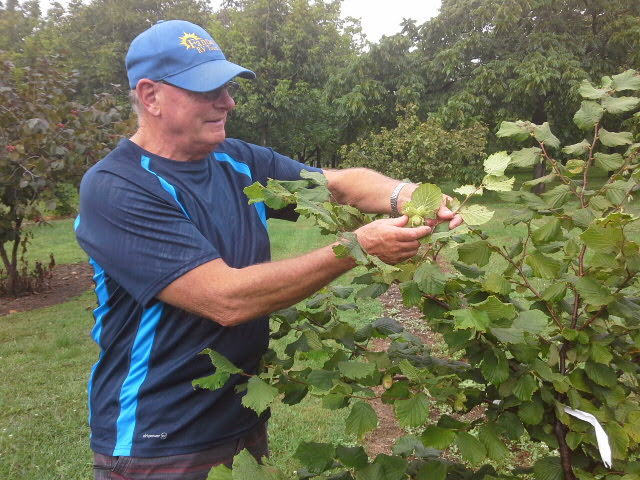
The tangled pile of uprooted trees in the center of the bare, frozen field was so large it dwarfed the nearby farmhouse. In the shadow of snow-capped mountains, Peter Andres watched as the pile erupted into a crackling flame that sent a single pillar of smoke straight up into the clear blue sky.
It was the winter of 2014 and Andres, like many other hazelnut growers in the Fraser Valley region of British Columbia, was destroying the last of his hazelnut trees lost to Eastern Filbert Blight. Burning is the best way to remove infected trees, according to guidelines from B.C.’s Ministry of Agriculture, Food and Fisheries. Still, it was an emotional experience for Andres. “Getting rid of the old trees…it took a lot of tears.”
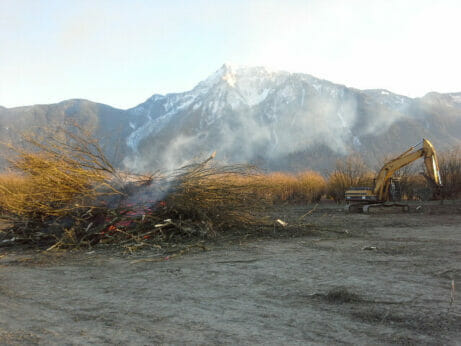
Peter Andres burned his hazelnut trees at his former farm in Agassiz, BC. Photography courtesy of Peter Andres.
Eastern Filbert Blight, a fungal disease spread by windblown spores that ultimately destroys infected trees, had spread from the east to west coast of North America in the late 1960s, initially into Washington and Oregon, then eventually into BC. The blight was first detected in BC in 2002; immediately, it was a race against the clock to slow its spread. Andres, then president of the BC Hazelnut Growers Association, worked with a team of growers to map impacted farms, trying to predict which would be hit next. They monitored orchards for symptoms and cut down infected trees. But as the fungus kills trees from the inside out for at least a year before they show symptoms, it was a losing battle.
The goal then shifted to securing a supply of blight-resistant trees for replanting. By the time the fungus reached BC, Oregon State University had already been breeding blight-resistant varieties for more than three decades in an effort to save Oregon’s official state nut. A quarantine was put in place by the Canadian Food Inspection Agency (CFIA) in 1975 to try to keep the disease out of BC. But the quarantine also prevented the import of these new blight-resistant trees from coming into the country. It took several years, but Andres and other growers were finally given the green light to bring tree tissue culture across the border in sterile test tubes. Using this culture, trees were cloned in a lab and raised by Nature Tech Nursery until ready to plant. Andres’ orchard was among the first in BC to trial the new varieties in 2011.
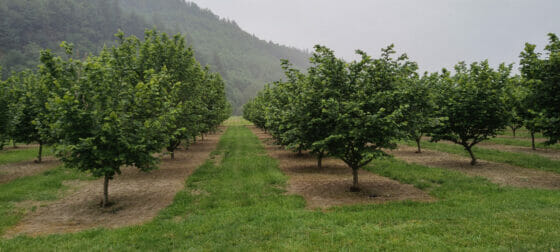
Rows of blight-resistant trees on Andres’s farm. Photography by Peter Andres.
Despite these efforts, the blight decimated the BC hazelnut industry. Hazelnut production declined from more than one million pounds pre-blight to around 25,000 pounds by 2017, a loss of nearly 98 percent. Andres recalls walking politicians through ravaged hazelnut orchards, making a case for government financial support to help keep the industry alive. “It’s about food security,” he explained at the time. As Andres notes, hazelnuts are the only nut grown commercially in BC, which produces approximately 90 percent Canada’s hazelnuts.
After six years, the BC hazelnut industry is finally in a period of renewal. After an initial push to attract new growers and expand the number of acres planted, and with support through the BC Hazelnut Renewal Program launched in 2018, hazelnut production is steadily increasing. The new varieties from Oregon have proven not only blight resistant but also higher yielding. “We’ve got nuts rolling off the fields,” says Zachary Fleming, president of the BC Hazelnut Growers Association. In 2021, BC produced more than 70,000 pounds of hazelnuts on around 350 acres. He’s hopeful that BC will be able to meet, if not surpass, pre-blight production levels within a decade.
The BC hazelnut industry is not a significant player in global production, nor does it wish to be. According to the United Nations Food and Agriculture Organization, Turkey is the largest supplier of hazelnuts, accounting for 62 percent of global production in 2020, followed by Italy and the United States. In North America, most hazelnuts are produced in Oregon’s Willamette Valley, with some production in Washington and BC. Oregon accounts for around 5 percent of the global production with nearly 100,000 acres planted (68,000 bearing acres in 2022). In comparison, BC hopes to reach 1,000 acres.
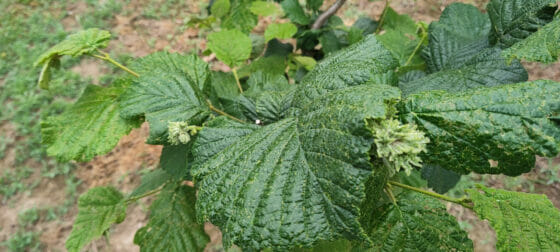
Photography by Peter Andres.
Ferrero Group, which makes Nutella, Ferrero Rocher and Kinder Surprise, buys around a quarter of the hazelnuts grown globally and has been looking at Canada to diversify its suppliers. While the BC Hazelnut Growers Association is open to the idea of supplying to Ferrero in the future, its focus for now is the local market. As Fleming explains, “There is enough global supply, so we aren’t looking to be a huge exporter. We want to produce BC products for BC.”
Fleming estimates that there are now around 100 growers in BC, and most of them are new. “There are a few [industry] pioneers out there who have replanted, perhaps less than five,” says Fleming. “It’s been a complete restart… so there’s a generational knowledge gap.” This knowledge gap is compounded by having to work with new varieties, which Fleming says might as well be entirely different species. “The first field I helped plant was five years ago, and we’ve made five years of mistakes.”
In addition to replanting, the lack of processing capacity was another hurdle faced by the BC hazelnut industry. With the supply of hazelnuts having dried up, the two former processing facilities in the Fraser Valley were forced to shut down. The call was answered by the Hooge family of Fraser Valley Hazelnuts Ltd. The property purchased by the family to expand its poultry production happened to be the site of a former processing facility. “All the growers that had replanted came to us and said ‘hey, can you start it up again?”recalls Kevin Hooge. “The whole future of the industry seemed to hinge on that decision.” So, the family dusted off the old equipment and got to work, gradually expanding its operation into a full processing facility that now services the entire BC hazelnut industry. Since opening in 2016, the plant has played a vital role in helping new and existing farmers get their hazelnuts to local customers.
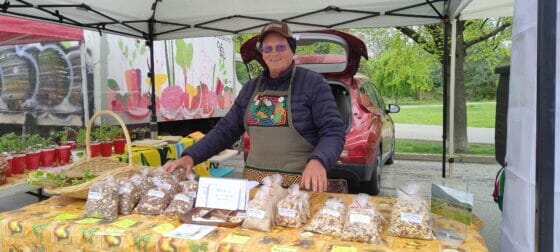
Peter Andres at his local farmer’s market. Photography courtesy of Peter Andres.
After clearing his fields, Andres needed a fresh start. In 2016, he purchased a new farm where he planted blight-resistant trees. Eager to pass on his nearly four decades of knowledge to the next generation of growers, Andres helped form the Hazelnut Growers Collective. Today, Andres can be found at the Vancouver Farmers Market selling hazelnuts under the banner of the Hazelnut Growers Collective. He first sold hazelnuts at the market out of the back of his pickup truck on a busy Thanksgiving weekend in 1997. After the blight hit his farm, Peter thought he would have to say goodbye to his market customers forever. Through the collective, growers co-ordinate their market attendance, prices and packaging. This means that their customers have a reliable supply, while allowing the growers greater flexibility.
The renewal of the BC hazelnut industry has required persevering farmers, enterprising processors, teams of researchers, cross-border collaborations and government support. Andres reflects on the last 15 tumultuous years “People always ask me, ‘Aren’t you sad that all your trees died?’ I’m sad, but in a way, I’m not sorry. Instead of us old fogies with the old farms and old varieties, we now have new ones. The industry got reinvigorated.”
I really enjoyed this story. I grew up eating Hazelnuts in Seattle, Washington. We moved to Southern California in late 1959, and I never saw another Hazelnut after moving here.
I missed them, there was never any species of nut that could compare.
I recently discovered Hazelnuts advertised on FB, and then found them at Trader Joe’s under the name “Oregon Hazelnuts”.
With all the Climate Changes, I’m hoping they continue to do well, and I salute Peter Andres for his “Never Give Up” attitude!
This is a fascinating story.
Do any of these nut growers use permacultural methods? In seeing the picture of the new hazelnut trees I imagined not and if correct wondered why.
Thank you in advance for your reply.
I live in Colorado, Denver metro. I would like to grow (start) two hazel nut trees. Can you recommend where to obtain same?